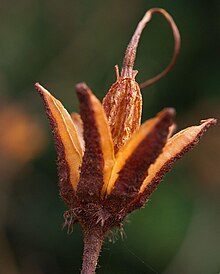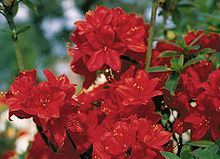Yellow azalea
| Yellow azalea | ||||||||||||
|---|---|---|---|---|---|---|---|---|---|---|---|---|

Yellow Azalea ( Rhododendron luteum ) |
||||||||||||
| Systematics | ||||||||||||
|
||||||||||||
| Scientific name | ||||||||||||
| Rhododendron luteum | ||||||||||||
| Sweet |
The Yellow Azalea ( Rhododendron luteum ), even Azalea called magic flower, Yellow Alpenrose, is a plant of the genus of rhododendron ( Rhododendron ). It is widespread in the Black Sea region (hence the nickname "Pontic" ), the Caucasus and like an island in various regions of Eastern and Southeastern Europe. Some varieties are used as an ornamental plant.
description
Vegetative characteristics
Rododendron luteum is a deciduous shrub with heights of up to 2, exceptionally up to four meters. It almost always grows without roots. The bark of young twigs is red-brown, more rarely yellow-brown, and densely covered with hair . In addition to single-celled trichomes, there are multicellular, rarely egg-shaped glandular hairs. The buds are also sticky due to glands.
The alternate leaves are divided into very short petioles and leaf blades. The shape of the simple leaf blades varies between ovate, obovate, elliptical to obverse lanceolate (oblanzeolate) with a pointed base and blunt, rarely pointed or pointed end. The leaves typically have a length of about 8 centimeters, a maximum of about 12 centimeters, their width is about 1.8 to 2.5 centimeters, exceptionally a little above or below. The leaf blades also have glandular hairs in different densities on both sides. The underside of the leaf is smooth, occasionally somewhat glaucous due to wax excretions , with clearly protruding leaf veins. The midrib of the leaf blade is hairy, the entire leaf margin is ciliated by glandular hairs. The leaves are shed in autumn, before they turn red.
Generative characteristics
The flowers appear shortly before or together with the newly emerging leaves in spring. Usually about 12 (9 to 17) flowers are grouped together in a terminal, racemose inflorescence .
The flowers are characterized by an intense, sweet fragrance. The hermaphrodite flowers are five-fold with a double flower envelope . The five green calyx lobes are about 4 millimeters long and strongly glandular. The conspicuous corolla is colored yellow with a dark yellow spot on the upper of the five corolla lobes, it is bell-shaped and weakly zygomorphic . The petals are fused at the base to form a tube with glandular hairs on the outside, about 1.5 centimeters long, which merge into the bell-shaped, free, elongated, egg-shaped petals without a sharp shoulder. The five stamens protrude from the corolla tube with a length of 2.5 to 4.5 centimeters, are yellowish or whitish in color and densely haired in the basal half by non-glandular hairs. The ovary is five-fold. The stylus is about 52 millimeters long.
Occurrence
The main distribution of the yellow azalea is in the region southeast of the Black Sea. It is common in the Pontic Mountains of Northern Anatolia, where it forms a characteristic element in the shrubby undergrowth of the deciduous and coniferous forests of the mountain forest level on acidic subsoil. It occurs north and east of the Black Sea from Novorossiysk in the west over the chains of the Greater Caucasus and Lesser Caucasus . In the east it is rapidly becoming rarer, but it occurs occasionally as far as the east of Dagestan . In the north-west of Anatolia, Rhododendron luteum is becoming increasingly rare, but occurs occasionally as far as the Aegean Sea. As the outermost outpost, it reaches the Greek island of Lesbos .
Apart from this closed area , the species occurs disjointly in island-like sub-areas in the Turkish Taurus Mountains and in southeastern Europe. A distribution area is in the Ukrainian Volhynia and Polesia , with a single isolated outpost in Poland, in Wola Zarczycka , which was discovered in 1909. In this region it grows in the undergrowth of moist, acidic pine forests and on the edge of swamps and moors.
Another isolated outpost was discovered in the south-eastern Alps, in Slovenia and Austria, it comprises only a few populations with few individuals, in Austria today there is probably only one shrub. In Slovenia there are finds at Gorjanci above Velike Brusnice , at Boštanj and at Topolovec , in acidic oak and chestnut forests. The only site in the German-speaking area is an occurrence that the Austrian teacher Rudolf Staber discovered on the Hühnersberg near Lendorf near Spittal an der Drau in Carinthia.
Although a natural occurrence here does not seem improbable, also due to pollen from earlier interglacials, some botanists assume a very early introduction by humans, possibly already in Roman times.
Aside from these natural occurrences, the yellow azalea is widespread from garden culture; it occurs as a neophyte not only in other regions of Poland, but also in Western Europe. In Germany there is a large overgrown population in the Kitzinger Forest near Großlangheim . For Germany it is assessed as a "naturalized neophyte".
Diseases
The naked basidia Exobasidium dubium , Exobasidium horvathianum and Exobasidium vaccinii cause growths on the leaves. The rust fungus Pucciniastrum vaccinii lives with parts on the leaves of the yellow azalea. The powdery mildew Erysiphe polygoni and Microsphaera penicillata form a white, wipeable coating. The fungi Colletotrichum gloeosporioides , Melanomma rhododendri and Phyllosticta berolinensis were also detected.
Relationship with people
The pollen of the yellow azalea contains the substance andromedotoxin, a grayanotoxin . This substance, which is poisonous for humans, is also transferred to the honey when the bees are collected . The resulting poisonous Pontic honey is responsible for a number of accidents. In its main distribution region, the Pontic Mountains, the yellow azalea is considered an undesirable " weed " that hinders the rejuvenation of forest trees and is sometimes combated with the use of herbicides .
Varieties of the yellow azalea are used as ornamental plants in parks and gardens . The yellow azalea is hardy and is counted among the outdoor azaleas.
The plant wasp Nematus lipovskyi , a Neozoic species introduced from the USA, has been registered as a pest on the yellow azalea since 2010 . The caterpillars of Nematus lipovskyi feed on the leaves and flowers.
Systematics
The new combination to Rhododendron luteum took place in 1830 by Robert Sweet . This species was made famous in Europe by Joseph Pitton de Tournefort and is also listed in the work Species Plantarum by Carl von Linné . Linnaeus named it Azalea pontica , he put all deciduous species in a separate genus Azalea , which is no longer justified. The common name " azalea " for the deciduous rhododendron species has been retained from her. Since Linné had already named a species other than Rhododendron ponticum , the recombination Rhododendron ponticum by Johann Christian von Schreber is an illegitimate younger homonym for this species , so that Sweets name had to be selected as a substitute name. Further synonyms are Rhododendron flavum G. Don , Azalea flava Hoffmannsegg .
Within the very species-rich genus Rododendron , Rhododendron luteum was traditionally listed with other "azaleas" in a section Pentanthera , which included 13 species from North America in addition to a Chinese species. According to the morphological and genetic data, closely related species are Rhododendron molle and Rhododendron occidentale , both from North America. According to genetic data, however, the sections Pentanthera and Hymenanthes are not monophyletic against each other, so that Rhododendron luteum is included in the Hymenanthes section . According to these data, the closest relatives are Rhododendron calendulaceum and Rhododendron canadense .
Web links
Individual evidence
- ↑ a b c d PF Stevens: Rhododendron L. In: PH Davis (editor): Flora of Turkey and East Aegean Islands , Volume 6, Edinburgh University Press: 852 pages, on pages 91-94.
- ↑ a b c d Sevim Alan, Mine Kürkçüoğlu, Fatih Göger, K. Hüsnü Can Başer: Morphological, chemical and indumentum characteristics of Rhododendron luteum Sweet (Ericaceae). In: Pakistan Journal of Botany , Volume 42, Issue 6, 2010, pp. 3729-3737.
- ↑ a b c d e f g KA Kron: A revision of Rhododendron section Pentanthera. In: Edinburgh Journal of Botany , Volume 50, Issue 3, 1993, pp. 249-364.
- ↑ a b c Thomas Sawidis, Theano Theodoridou, Elzbieta Weryszko-Chmielewska, Artemios M. Bosabalidis: Structural features of Rhododendron luteum flower. In: Biologia , Volume 66, Issue 4, 2011, doi : 10.2478 / s11756-011-0059-5 , pp. 610-617.
- ↑ Mieczyslaw Czekalski: Rhododendrons former in the Soviet Union. In: Journal of the American Rhododendron Society , Volume 52, Issue 2, 1998 ( online at lib.vt.edu).
- ↑ Tomasz Anisko: Pontic Azalea in Poland. In: Journal of the American Rhododendron Society , Volume 47, Issue 4, 1993 ( online at lib.vt.edu).
- ↑ a b Jerzy Piórecki, Eugeniusz Dubiel: Volhynian Polesia - main source of the Yellow Azalea. In: Rocznik Polskiego Towarzystwa Dendrologicznego , Volume 57, 2009, pp. 29–32.
- ↑ Gustav Wendelberger: From the yellow alpine rose. In: Natur und Land , Vol. 48, 5, 1962, pp. 114–119 ( PDF on ZOBODAT ).
- ↑ Rudolf Staber: Rhododendron flavum Don. and other new plants in Upper Carinthia. In: Carinthia II. 123/124. (43./44.) Year, Klagenfurt 1934, pp. 46–51 ( PDF on ZOBODAT ).
- ↑ Azaleas. In Thomas Meyer: Flora-de: Flora von Deutschland (old name of the website: Flowers in Swabia).
- ↑ Rhododendron luteum Sweet, Pontic Azalea. In: FloraWeb.de.
- ↑ David F. Farr, H. Bartolome Esteban, Mary E. Palm: Fungi on Rhododendron: A World Reference. Parkway Publishers, Inc., 1996, p. 15 (available from Google Books ).
- ↑ Derya Eşen, Oktay Yildiz, Şemsettin Kulaç, Murat Sarginci: Controlling Rhododendron spp. in the Turkish Black Sea Region. In: Forestry Volume 79, 2, 2006, doi : 10.1093 / forestry / cpl008 , pp. 177-184.
- ↑ January Macek, Petr Šipek: Azalea sawfly Nematus lipovskyi (Hymenoptera: Tenthredinidae), a new invasive species in Europe. In: European Journal of Entomology , Volume 112, Issue 1, 2015, doi : 10.14411 / eje.2015.018 , pp. 180–186.
- ↑ SM Scheiber, RL Jarret, Carol D. Robacker, Melanie Newman: Genetic relationships within Rhododendron L. section Pentanthera G. Don based on sequences of the internal transcribed spacer (ITS) region. In: Scientia Horticulturae , Volume 85, 2000, pp. 123-135.
- ↑ Loretta Goetsch, Andrew J. Eckert, Benjamin D. Hall: The Molecular Systematics of Rhododendron (Ericaceae): A Phylogeny Based Upon RPB2 Gene Sequences. In: Systematic Botany , Volume 30, Issue 3, 2005, doi : 10.1600 / 0363644054782170 , pp. 616-626.





